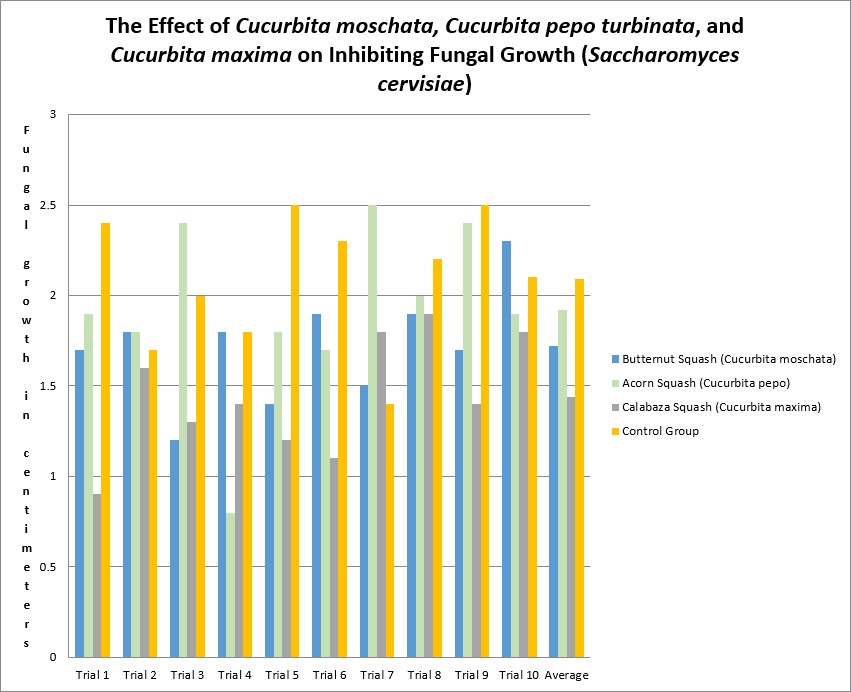Abstract. The investigation used antimicrobial proteins found in the rinds from Cucurbita moschata, Cucurbita pepo turbinata, and Cucurbita maxima to see inhibition of the growth of Saccharomyces cerevisiae. Thirty petri dishes were treated with the genus, Cucurbita, to determine if a certain species could inhibit fungal growth. A streak of yeast was placed through each petri dish that was treated with one of the rinds from the Cucurbita genus. The F- test was used to determine if there was a significant difference between the groups treated with the Cucurbita moschata, Cucurbita pepo turbinata, Cucurbita maxima and the control group. The data supported the hypothesis that petri dishes treated with Cucurbita would inhibit Saccharomyces cerevisiae growth.
Introduction. The avocado industry, and other plant industries, are seeking methods to stop fungal growth from ruining crops. Using an organic treatment, rather than a synthetically made fungicide can serve two functions, one being not specific to a certain type of fungal growth, and the second being that organic fungicides will not harm nor contaminate the areas. This will alleviate the concern of runoff of fungicides getting into water supply and harming natural pollinators of the crops.
Research Hypothesis. Antimicrobial proteins within Cucurbita moschata, Cucurbita pepo turbinata, and Cucurbita maxima will inhibit Saccharomyces cerevisiae growth.
Null Hypothesis. There is no significant difference in the mean averages of Saccharomyces cerevisiae (Baker’s yeast) growth when treated with antimicrobial proteins found in Cucurbita moschata, Cucurbita pepo turbinata, and Cucurbita maxima.
Procedures. Within a sanitized environment, prepared agar petri dishes were treated with antimicrobial proteins found within Cucurbita moschata, Cucurbita pepo turbinata, and Cucurbita máxima treatments streaked three times with prepared Saccharomyces cerevisiae (Baker’s Yeast) in a parallel line to each other. After four days, growth width of Saccharomyces cerevisiae (Baker’s Yeast) was measured.
Data.


|
Descriptive Information (Table 1.1)
Growth of Saccharomyces cerevisiae Baker’s Yeast
|
Cucurbita moschata (Butternut Squash)
|
Cucurbita pepo turbinata (Acorn Squash)
|
Cucurbita máxima
(Calabaza Squash)
|
Control Group
(Untreated)
|
|
Mean
Variance
Standard Deviation
1 SD (68%Band)
2 SD (95% Band)
3 SD (99% Band)
Number
|
1.72
0.0928
0.304
1.416 – 2.024
1.112 - 2.328
0.808 – 2.632
10
|
1.92
0.237
0.487
1.433 – 3.353
0.946 – 3.840
0.459 - 4.327
10
|
1.44
0.109
0.330
1.110 – 1.770
0.780 – 2.100
0.450 - 2.430
10
|
2.09
0.134
0.366
1.724 – 2.456
1.358 – 2.822
0.992 – 3.188
10
|
|
Results of F-Test
|
Calculated F =5.44
Critical F =2.87
|
Df = 3, 36
Rejected
|
P > 0.10
Α = 0.05
|
|
Results. The effect of antimicrobial proteins within Cucurbita moschata, Cucurbita pepo turbinata, and Cucurbita máxima on the growth of Saccharomyces cerevisiae (Baker’s Yeast) is summarized in Table 1.1. Saccharomyces cerevisiae treated with Cucurbita moschata had a mean average growth of 1.72 cm, a variance of 0.0928 and a standard deviation of 0.304. Ninety-five percent of the Cucurbita moschata treatments fell within the range of 1.112 to 2.328 centimeters of Saccharomyces cerevisiae growth. Saccharomyces cerevisiae treated with Cucurbita pepo turbinata had a mean average growth of 1.92 cm, a variance of 0.237 and a standard deviation of 0.487. Ninety-five percent of the Cucurbita pepo turbinata treatments fell within the range of 0.946 to 3.840 centimeters of Saccharomyces cerevisiae growth. Saccharomyces cerevisiae treated with Cucurbita maxima had a mean average growth of 1.44 cm, a variance of 0.109 and a standard deviation of 0.330. Ninety-five percent of the Cucurbita maxima treatments fell within the range of 0.780 to 2.100 centimeters of Saccharomyces cerevisiae growth. Saccharomyces cerevisiae not treated had a mean average growth of 2.09 centimeters, a variance of 0.134 and a standard deviation of 0.366. The F-test was used to test the following null hypothesis at the 0.05 level of significance: There is no significant difference in the mean averages of Saccharomyces cerevisiae (Baker’s yeast) growth when treated with antimicrobial proteins found in Cucurbita moschata, Cucurbita pepo turbinata, and Cucurbita maxima.
The null hypothesis was not rejected (calculated f = 5.44 > 2.87 at Df 3,36; p>0.10). The research data did support the research hypothesis treatments of Cucurbita antimicrobial proteins will be a inhibit the Saccharomyces cerevisiae growth.
Conclusions. The effect of antimicrobial proteins within Cucurbita moschata, Cucurbita pepo turbinata, and Cucurbita máxima on the growth of Saccharomyces cerevisiae (Baker’s Yeast) was investigated after a four day period in comparison with a control group left untreated. Significant differences existed in the growth of Saccharomyces cerevisiae treated with antimicrobial proteins within Cucurbita moschata, Cucurbita pepo turbinata, and Cucurbita máxima and the untreated Saccharomyces cerevisiae (Baker’s Yeast) sample. The research hypothesis Antimicrobial proteins within Cucurbita moschata, Cucurbita pepo turbinata, and Cucurbita maxima will inhibit Saccharomyces cerevisiae growth than untreated control group. The possible explanations for the current experimental data is that organic fungicides are not specific and can be an effective method for treating fungal growth. Additional investigations on more specific antimicrobial proteins on other types of fungal growth should be completed.
References.
(1) Harrington, T. C., & Fraedrich, S. W. (2010). Quantification of Propagules of the Laurel Wilt Fungus and Other Mycangial Fungi from the Redbay Ambrosia Beetle, Xyleborus glabratus. Phytopathology,100(10), 1118-1123. doi:10.1094/phyto-01-10-0032
(2) Mayfield, A. E., Smith, J. A., Hughes, M., & Dreaden, T. J. (2008). First Report of Laurel Wilt Disease Caused by a Raffaelea sp. on Avocado in Florida. Plant Disease,92(6), 976-976. doi:10.1094/pdis-92-6-0976a
(3) Park, S., Kim, J., Lee, J., Hwang, I., Cheong, H., Nah, J., . . . Park, Y. (2009). Antifungal Mechanism of a Novel Antifungal Protein from Pumpkin Rinds against Various Fungal Pathogens. Journal of Agricultural and Food Chemistry,57(19), 9299-9304. doi:10.1021/jf902005g
(4) Texas A&M Agrilife Extension. (n.d.). Retrieved January 11, 2019, from https://plantdiseasehandbook.tamu.edu/food-crops/fruit-crops/avocado/
(5) Thomas, T., Eicker, A., & Robbertse, P. (1994). Possible role of fungi in negatively affecting fruit-set in avocados.
South African Journal of Botany,60(5), 251-256. doi:10.1016/s0254-6299(16)30599-3





